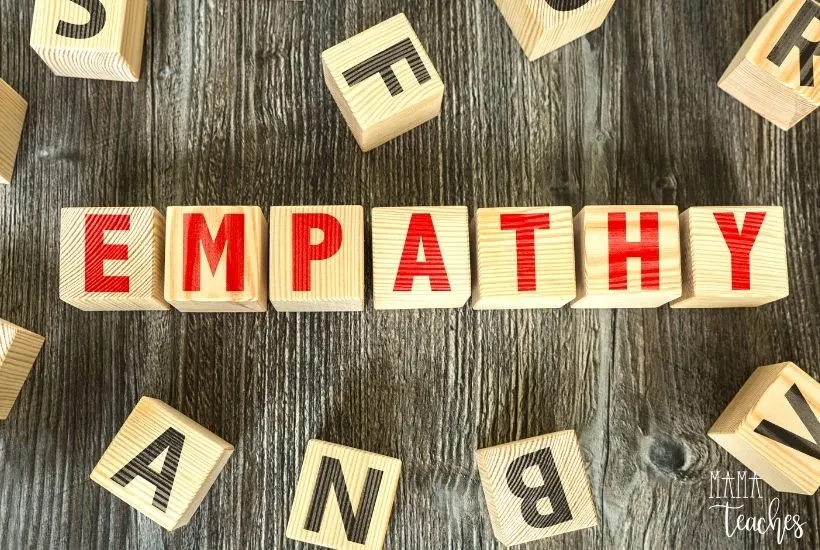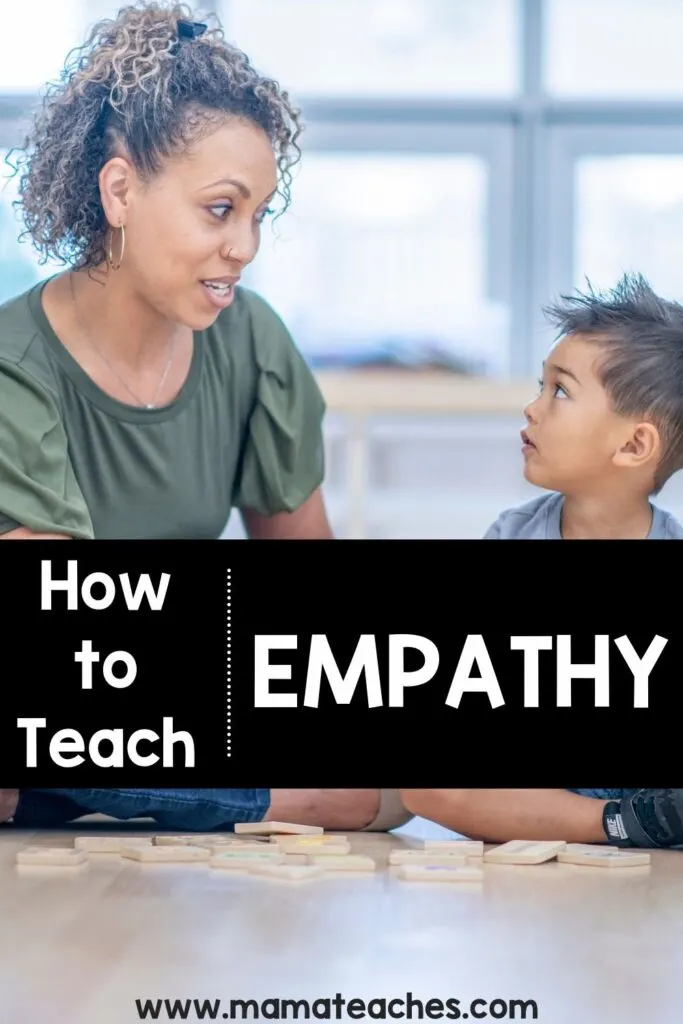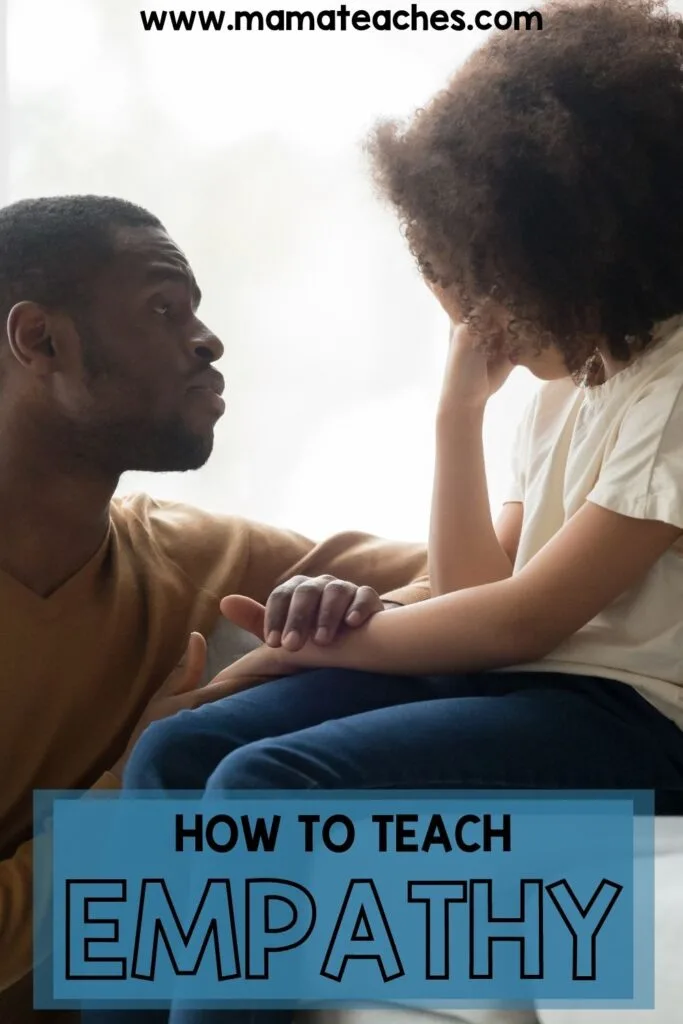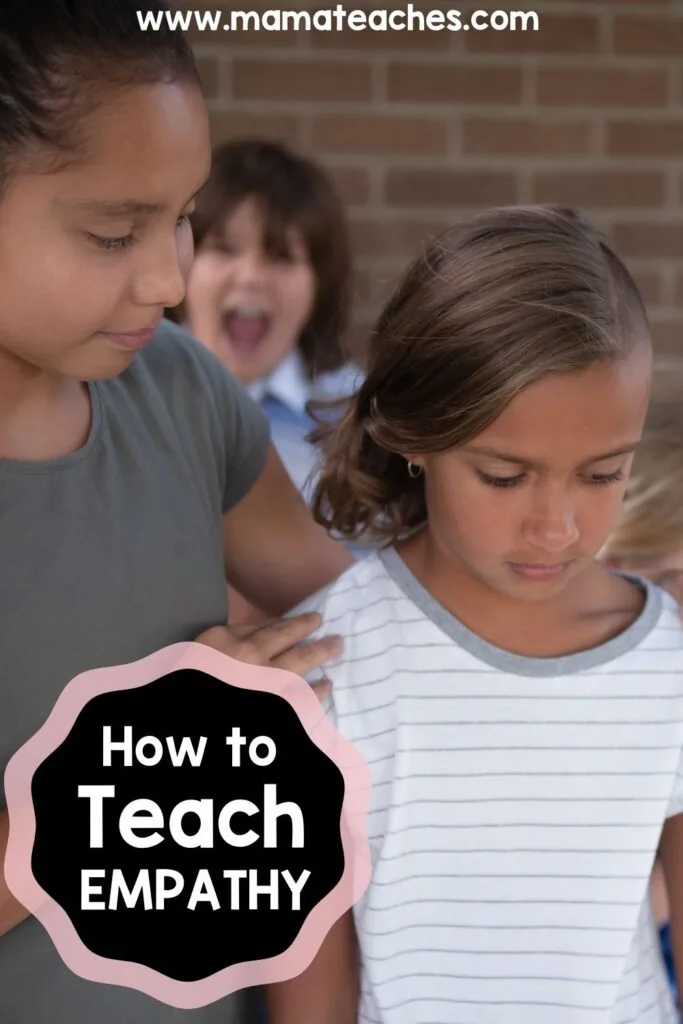The world would be a better, kinder place if we all had a little empathy.
Learn how to teach empathy to your kids.
Teaching Empathy
Empathy builds connections between people, and that is the foundation of any friendship, community, and society.
It involves recognizing social cues and responding appropriately.
Empathy is a vital skill, helping both the person in need and the person reaching out.

This article contains affiliate links to things that you might like.
What Is Empathy?
Empathy is the ability to understand and share the feelings of others.
It is actually three-fold.
Understanding
The first component of empathy is a mental understanding that comes from being able to see from the other person’s perspective (“I understand what you’re experiencing.”).
This could be because you have experienced what the other person is now going through, or it could be because you can imagine yourself in the same position.
Feeling
An empathetic person can, in part, feel what the other person is feeling (“I’m hurting for you.”).
This is the second component of empathy.
It’s as if the person’s emotions are contagious, and you feel them to a certain extent as well.
Compassion
In the third component of empathy, you are moved to action to help the person in need (“What can I do to help you?”).

How Do Children Learn or Develop Empathy?
Empathy begins to develop as young as two years of age in some children.
Whenever a toddler sees another child in pain and feels sad themselves, or tries to soothe the hurting child, that is empathy at work.
Empathy begins to develop when the child has a sense of self.
A child must first learn to recognize his own emotions before he can identify them in others.
In the beginning, a child’s empathy only extends to situations that he has experienced himself.
As a child grows, he improves in his ability to read social cues.
These social skills are necessary before a child can show empathy when needed.
Sometimes a person’s feelings are not obvious (like full-blown crying).
A person may reveal his feelings with an awkward pause, a furrowed brow, a trembling lip, or averted eyes.
Reading those nonverbal cues is pivotal.
How can you show empathy if you can’t recognize when someone is upset?
Once a child has reached elementary age, her ability to put herself in another’s shoes increases.
She can imagine what someone feels in a situation that she has never experienced herself.
That mental picture may be strong enough for her to feel similar feelings and be moved in compassion.
Ways to Teach Empathy
The first and best way to teach empathy to a child is to model it yourself.
Children learn from experience, so when you extend empathy to them, they learn how to extend that care and concern to others.
When a child skins his knee, you don’t minimize his pain.
When you react with compassion, your child is learning the appropriate response to this situation.
You also model empathy to your child in your interactions with others.
How do you treat the people in your life?
When you bring a meal to a new mom, pick up some groceries for an elderly neighbor, or even pass a dollar to someone in need, your child is watching and learning.
One day he will be able to show empathy to others in that same way.

Activities for Parents to Do at Home
These activities are ideal for parents to do at home with their children.
Identify Emotions
Young children (and even older children) can be overwhelmed with negative emotions, so much so that they can’t name them.
Often we feel a mixture of sadness and anger, or frustration and anger, or relief and guilt.
Help your child sort through exactly what he is feeling by asking guiding questions (“How did it make you feel when…”).
This process of naming emotions begins when children are very young, but it should continue as children enter the teen years and experience a wider range of feelings and complex social situations.
Subtle Role Play
To practice social skills, try informal role play.
If a child misses an opportunity to show empathy, you can pull him aside and ask him to place himself in the person’s position (“How would you feel if…?”).
You can also do this in situations where the child is not involved.
If you hear, for example, that one of your child’s friends didn’t make the soccer team, you could say, “I wonder how she feels…” which subtly invites your child to consider and respond.
Narrate Books and Movies
Books and movies are a wonderful way to imagine yourself in someone else’s position.
Ask your child questions about a character’s thoughts, motivations, and displays of emotion.
When a character is in trouble, ask your child, “What would you say?” or “What would you do to help?”
Practice Reading Cues
Photographs and expressive drawings are a great way to practice reading nonverbal cues.
Use pictures without text and ask your child, “What do you think that person is feeling? How can you tell?”
Express Yourself
If you have had a hard day, share it.
If you are struggling, sad, or frustrated, name it.
You may think it is best to always put on a happy face for your child, but you are probably not as good of an actor as you think.
You can actually help your child learn to recognize emotions by naming your own.
Who knows?
He may surprise you with an empathetic response.

Activities for Teachers to Do in the Classroom
Empathetic children are better listeners, better learners, and better members of the community.
Check out these activities to teach empathy in your classroom.
Teach Children to Manage Emotions
Children need to know how to manage emotions, both to regulate their own responses and to help others who are struggling.
Teach coping strategies to deal with anger, frustration, and sadness.
(These strategies make great bulletin board ideas!)
Make sure kids know that sharing how they feel and asking for help is the best and bravest thing they can do.
Notice and Reject Stereotypes
Empathy evaporates if students can’t see their common humanity.
Stereotypes divide and give the child permission to put up emotional walls. (e.g. “I don’t feel bad for them because they are all ___.”)
Establish a code of conduct in your classroom where you show everyone respect and consideration.
Read books with characters with varying backgrounds and experiences; first-person stories help students identify with the narrator and promote understanding.
Widen Their Circle
Children must learn to see beyond their experience.
Community service projects are wonderful ways to widen a student’s circle since they interact with others and help those in difficulty.
Another great way to widen the circle?
Connect to students across the globe with a pen pal program.

How to Teach Empathy to Children
Children are constantly learning, and their capacity to empathize will increase as they grow.
Help them along in their journey by teaching empathy with these tips and activities.
